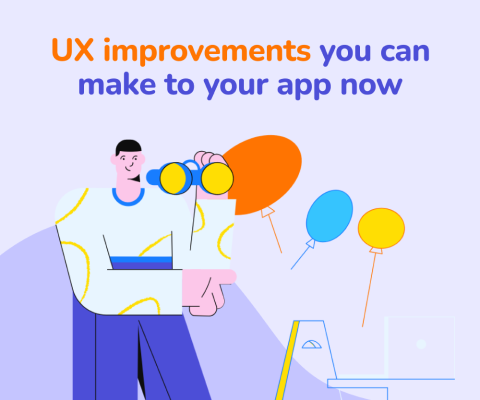December 17th, 2025, posted in for_founders
by Adelina
Nowadays, where mobile applications are king, app design techniques have become essential to effective product creation. App design systems are made up of reusable parts, guidelines, and a set of guiding principles that guarantee efficiency, scalability, and consistency throughout the design and development process.
Understanding the complex nature of app design systems is not just a choice, but a strategic need. A key factor that influences the user experience and general success of an app being the role that executives play as the drivers behind innovation and product strategy. Therefore, making decisions, coordinating teams, and providing value to users all depend on having a firm understanding of design principles.
Let's now take a closer look at each of these concepts and learn how to use them in your app development goals.
Consistency
Consistency isn't just about making sure all the buttons look the same; it's the glue that holds your app together. Users will feel more comfortable navigating your app when everything is consistent, from the layout and interactions to the colors and fonts. Imagine it like entering your go-to coffee shop; you know exactly where to look for the menu and where to pay because it's the same. That's the level of familiarity and comfort that consistency gives your app.
Why does it matter?
Improved user experience - Imagine if every page of a book had a different font and layout – it'd be chaotic and confusing, right? The same goes for apps. Consistency creates predictability, making it easier for users to find what they need and complete tasks without friction.
Brand identity - Your app is like your brand's digital storefront, and consistency is how you maintain brand integrity. When it looks and feels consistent across all touchpoints, it reinforces your brand identity and builds trust with your audience.
Take for example Instagram. The app keeps a consistent design from the moment you launch it. Whether you're exploring stories, uploading a photo, or browsing through your feed, the UI feels comfortable and natural, which improves the user experience in general.
Google's design language, Material Design, is all about consistency. All Google apps, from Gmail to Maps, have a consistent and identifiable user experience thanks to Material Design, which uses techniques like elevation and shadows as well as standardized icons and color schemes.
By prioritizing consistency in your app design, you're not just making things easier for your users – you're also strengthening your brand and setting your app up for long-term success. So, when in doubt, stick to the script and keep things consistent!
 Source: Figma.com
Source: Figma.com
Scalability
Scalability is about future-proofing your application for growth and evolution, not just about managing an unexpected spike in users. A scalable design system creates the room necessary for your app to grow and change without difficulty. Consider it like building a house: you want a sturdy framework that will allow for future additions of rooms without requiring a total reconstruction.
Future-Proofing - Your app can grow naturally and anticipate future needs with a scalable design system. Scalability makes sure your app can handle any challenges it faces, whether you're expanding to new platforms, adding new features, or managing higher user traffic.
Flexibility - Scalable design systems allow you to create new experiences without having to start from scratch by mixing and matching components, much like with Lego sets. This adaptability encourages creativity and experimentation in addition to saving time and money.
As one of the largest streaming platforms in the world, Netflix relies on a scalable design system to deliver a consistent experience across a wide range of devices and screen sizes. Whether you're watching on your TV, smartphone, or tablet, the Netflix interface remains familiar and intuitive, thanks to its scalable design architecture.
Another example is Airbnb. With millions of listings across the globe, the platform's design system must expand easily to meet the various needs of both hosts and visitors. Airbnb's interface changes dynamically to offer users worldwide a personalized experience, from searching for accommodation to making a reservation.
By giving scalability top priority in your app's design, you're future-proofing it for success, in addition to preparing for growth. So, aim high but use intelligent design, and watch your app reach new heights!
 Source: Foxbusiness.com
Source: Foxbusiness.com
Modularity
Modularity is the ability to divide your app into smaller, reusable parts that are easy to assemble and rearrange. It's similar to building with Lego blocks. Modular design enables you to build a library of building blocks that can be combined and matched to create a variety of features and layouts, saving you the trouble of starting from scratch every time. It all comes down to encouraging efficiency and adaptability in the app development process and working smarter, not harder.
Reusable components - Every component in a modular design system has its own purpose and can be applied to other areas of the app. Buttons, cards, and navigation menus save time and effort by cutting out the need to start from scratch with every new feature or screen.
Flexibility and customization - Without being constrained by rigid structures, modular design allows designers and developers to quickly adapt and iterate. Do you need to change a feature or adjust the color scheme? No problem—changing modular components is as simple as exchanging a Lego brick.
Let's take a look at Spotify. With millions of users worldwide, the app has to be compatible with a wide variety of devices and preferences. From making playlists to finding new music, Spotify's modular design system makes it easy to customize and personalize, guaranteeing a unique experience for every user.
Another one is Duolingo. This app uses a gamified approach to language learning, and a modular design system to create interesting and dynamic lessons. Because each lesson consists of modular elements like exercises and quizzes, learners can advance at their own speed and still have an enjoyable learning experience.
Incorporating modularity into your app design not only streamlines the development process but also establishes the foundation for an app that can grow, adapt, and survive over time.
Accessibility
Accessibility is all about making sure your app is usable and enjoyable for everyone, regardless of their abilities or disabilities. It's not just a matter of law; it's also a moral duty and a chance to design inclusive experiences that enable every user to fully engage in the digital world. Everyone can use and interact with your app with ease if it is designed with accessibility in mind, regardless of their ability to see or move.
Why does accessibility matter?
Inclusivity - More than just compliance, accessibility also involves empathy and inclusion. You can reach a wider audience and make sure that everyone, regardless of ability, can use your app by designing with accessibility in mind.
User experience - Everyone's overall user experience is often improved by designing with accessibility in mind. Better usability for all users, including those with disabilities, results in increased engagement and satisfaction. Other benefits include easier navigation, higher color contrast, or clearer typography.
Key guidelines for accessibility
Color contrast - Text should have enough contrast with the background color to make the content easier for visually impaired users to read. You can find and address contrast problems in your app with the use of tools like color contrast checkers.
Typography - Users with dyslexia or low vision can read more easily when clear, readable fonts are used with the right font sizes and spacing. Select sans-serif fonts instead of ornate or highly stylized fonts.
Navigation - Creating logical and consistent navigation paths facilitates users' exploration of your application. For users who have mobility issues, make use of keyboard shortcuts, logical grouping, and descriptive labels to improve accessibility.
Not only are you sticking to the law when you prioritize accessibility in your app design, but you're creating a more equal and inclusive online community for all users.
Collaboration
Collaboration is the key to bringing together the many skills and opinions of designers, developers, and stakeholders, to produce truly amazing work. It takes more than just exchanging files and showing up to meetings to build a culture of cooperation, creativity, and teamwork that encourages everyone to offer their best suggestions and areas of knowledge.
Why does it matter?
Different perspectives - When people with various experiences, abilities, and viewpoints collaborate, the design process improves and more creative solutions are produced. By using your team's mixed intelligence, you can look into new ideas, reject misconceptions, and expand the boundaries.
Alignment ownership - Effective collaboration ensures that everyone is on the same page and invested in the success of the project. Stakeholders can be encouraged to take ownership and responsibility for the project by involving them early on and maintaining open lines of communication.
Strategies for successful teamwork
Clear communication - Maintain open channels of communication and be explicit about roles, duties, and due dates. Everyone can stay informed and on task with the use of project management tools, stand-up meetings, and regular check-ins.
Cross-functional teams - Create cross-functional teams with designers, developers, marketers, and other stakeholders to dismantle silos and promote cooperation across disciplines. This makes it possible to solve problems and make decisions in a more comprehensive manner.
Iterative design process - Use a methodical approach to design that promotes input and cooperation at every turn. Early and regular prototyping allows you to get feedback from stakeholders and end users, iterate your designs in response to their criticism, and refine your final products until they are perfect.
Slack is an example of joint effort involving users, developers, and designers. Through user research and beta testing, as well as user involvement in the design process, Slack was able to develop an app that meets the needs of modern teams.
Cooperation and communication can help your team to develop apps that not only satisfy user needs but also push the boundaries of innovation.
Documentation
Solid documentation is the true base of app design systems, giving stakeholders, developers, and designers a road map to help them navigate the intricate details of the design process. It's not just a formality; throughout the development lifecycle, it's an essential tool for preserving consistency, encouraging teamwork, and guaranteeing that everyone is on the same page.
Why does documentation matter?
Keeping consistency - The purpose of documentation is to guarantee that all team members follow a common vision and aesthetic by acting as a reference guide for design principles, guidelines, and best practices. From color palettes and typography to interaction patterns and layout guidelines, comprehensive documentation helps maintain visual and functional consistency across the app.
Facilitating collaboration - Collaboration can be simplified by documentation, which gives everyone a common language to use when exchanging ideas, receiving criticism, and monitoring developments. By documenting design decisions, rationale, and iterations, teams can collaborate more effectively and resolve conflicts or misunderstandings before they escalate.
Essential types of documentation
Style guides - Style guides outline the visual and interactive elements of the app, including color palettes, typography, iconography, and UI components. They serve as a reference for designers and developers to keep consistency in design implementation.
UI Kits - These are pre-made templates and interface elements that can be quickly customized and incorporated into an application. They offer a library of ready-to-use components, which speeds up the design process and guarantees consistency.
Tips for effective documentation
Keep it up-to-date - Along with the app, the documentation should change to reflect new features, design patterns, and user feedback. Check and update documentation frequently to make sure it is accurate and relevant.
Make it accessible - Make sure that all team members have access to the documentation. Encourage involvement and feedback from all stakeholders by organizing documentation using collaborative tools and platforms.
Give context - Explain not only the decisions that were taken but also the reasoning behind them. To give context and clarity for design decisions, include justification, results from user research, and design principles.
By prioritizing proper documentation in your app design process you're helping your team to work more efficiently, collaborate more effectively, and deliver the best app experiences.
The basic principles of app design systems are like markers, showing the way to developing unique and intuitive apps. Each one, from accessibility and collaboration to consistency and scalability, plays a huge part in influencing the design and development process, leading to apps that connect with users and drive business growth.
When you start your app development journey the best advice is to apply these principles purposefully and intentionally. Consider the following design process tenets: documentation, accessibility, scalability, modularity, and collaboration.
Engage every member of your team, including the product managers, marketers, and developers, in the discussion. You can develop apps that not only satisfy your users' needs but also go above and beyond their expectations, increasing engagement, loyalty, and success, by collaborating and putting the needs and experiences of your users first.
If you need a hand with your app, why not book a consultation with us? We'll take a look at your product and give you a free UI/UX assessment and actionable improvement recommendations for 3-4 complex screens.


















